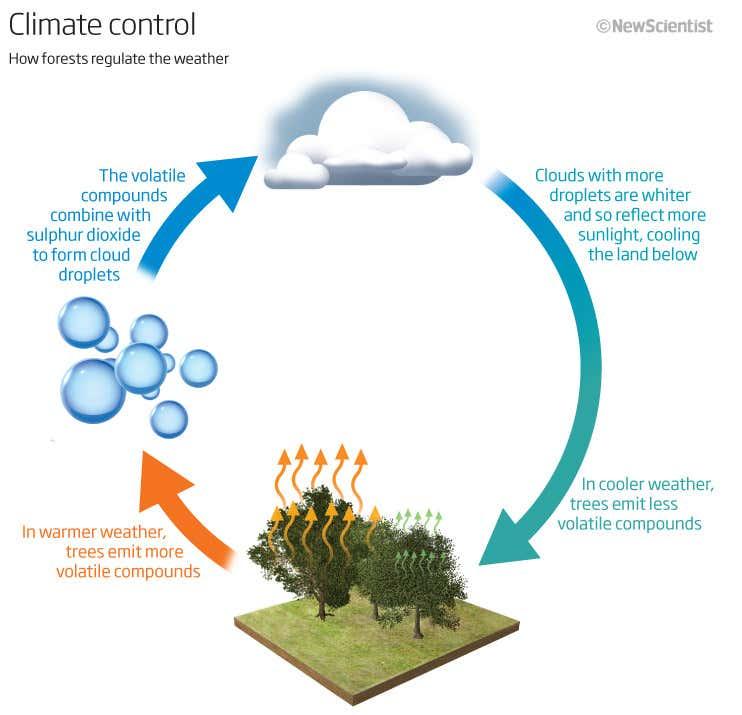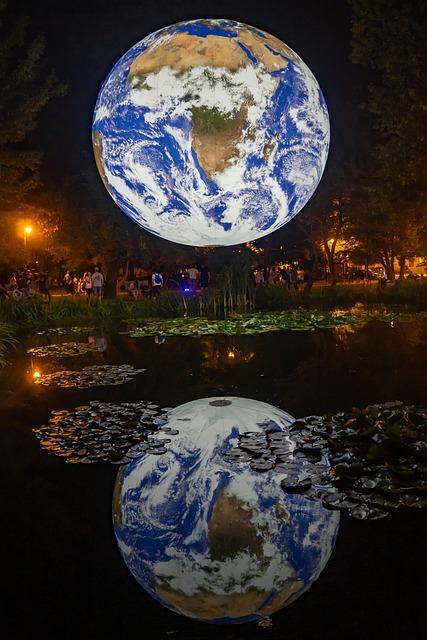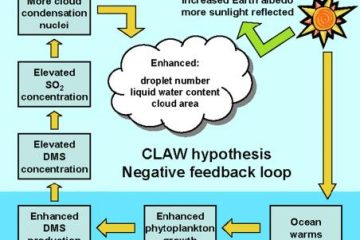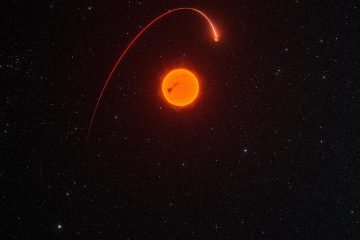Table of Contents
- Exploring the Essence of the Gaia Hypothesis
- Understanding Gaias Role in Earths Systems
- Investigating the Interconnectedness of Life and Environment
- Practical Applications of the Gaia Hypothesis in Conservation
- Future Perspectives on the Gaia Hypothesis and Sustainability
- Q&A
- Wrapping Up
Exploring the Essence of the Gaia Hypothesis
The Gaia Hypothesis proposes a revolutionary view of the Earth: that life and the environment function as a single, self-regulating entity. At its core, the hypothesis was formulated by scientist James Lovelock in the 1970s, suggesting that the Earth’s biological and physical systems are interconnected in such a way that they promote conditions conducive to life. This perspective pushes us to redefine our understanding of ecology, emphasizing the interdependence of organisms and their habitats. By viewing the Earth as a living organism, we gain insights into the delicate balance necessary for sustaining life.
This concept posits several key principles that challenge traditional views of biology and geology. Among these are:
- Life influences the environment: Organisms actively shape the climate and chemistry of the planet.
- Self-regulation: Earth’s systems work collectively to maintain conditions favorable for life.
- Feedback mechanisms: Changes in one part of the ecosystem can trigger responses in others, ensuring stability.
To further illustrate the essence of the Gaia Hypothesis, we can look at its implications through a simple comparison of conventional vs. Gaia-oriented perspectives. The table below summarizes these contrasting viewpoints:
| Traditional View | Gaia Hypothesis View |
|---|---|
| Life and the environment are separate entities. | Life and the environment are inherently linked. |
| Organisms are merely affected by their surroundings. | Organisms actively influence their surroundings. |
| Environmental change is often detrimental to life. | Change can promote adaptation and resilience. |

Understanding Gaias Role in Earths Systems
At the core of understanding Gaia’s role within Earth’s systems is the concept that our planet behaves as a single, self-regulating entity. This system operates through complex interactions between the biosphere, atmosphere, lithosphere, and hydrosphere. Each component contributes to the stability and resilience of the Earth, highlighting the interconnectedness of life and the environment. For instance, living organisms play a significant role in regulating the climate and maintaining optimal conditions for life through processes such as photosynthesis and respiration.
Key processes illustrating Gaia’s influence include:
- Carbon Cycle: Organisms absorb and release carbon, helping to manage global temperatures.
- Nitrogen Fixation: Certain bacteria convert atmospheric nitrogen into forms usable by plants, which supports life.
- Water Cycle: Evaporation from plants and other surfaces contributes to cloud formation and precipitation cycles.
Furthermore, Gaia theory posits that these coupled processes create a feedback loop that maintains conditions conducive to life. When these systems encounter disturbances, whether from natural events or anthropogenic influences, they exhibit resilience through self-correcting mechanisms. For instance, if atmospheric CO2 levels rise drastically due to industrial activity, biological processes such as increased photosynthesis can help restore balance. This understanding underscores the importance of protecting our ecosystems to ensure the continued health of our planet’s complex systems.

Investigating the Interconnectedness of Life and Environment
The relationship between living organisms and their environment is a dynamic interplay that continues to fascinate scientists and philosophers alike. Central to this exploration is the idea that all life on Earth is intricately linked and contributes to the stability and resilience of our planet’s ecosystems. This interconnectedness suggests that changes in one aspect of the environment can create ripples through the entire system, affecting not just the immediate surroundings but also distant ecosystems. For example, the extinction of a single species can lead to a cascade of biological changes, influencing everything from predation patterns to the availability of resources.
Key factors that underscore this interdependence include:
- Energy flow: The transfer of energy through food webs illustrates how species rely on one another for survival.
- Nutrient cycling: Elements such as carbon and nitrogen are recycled through various biological processes, emphasizing the necessity of diverse organisms in maintaining ecological balance.
- Climate regulation: Vegetation plays a pivotal role in sequestering carbon dioxide, showcasing how flora contributes to climate stability.
Understanding these intricate connections can also help guide conservation efforts. By adopting a holistic view of ecosystems, we can prioritize actions that protect not only individual species but also their habitats. A systemic approach enables us to address environmental challenges more effectively. The table below summarizes critical aspects of life-environment interactions:
| Interaction | Description | Impact on Ecosystem |
|---|---|---|
| Predation | One species consumes another, regulating population sizes. | Maintains biodiversity and prevents overpopulation. |
| Symbiosis | Mutual relationships between species enhance survival. | Fosters species diversity and resilience. |
| Decomposition | Breakdown of organic matter returns nutrients to the soil. | Essential for fertility and ecosystem productivity. |

Practical Applications of the Gaia Hypothesis in Conservation
The Gaia Hypothesis posits that the Earth functions as a single, self-regulating system, which is particularly pertinent when considering conservation efforts. By viewing ecosystems as interconnected and dynamic, conservation strategies can be developed that emphasize the holistic relationships within and between various environments. This perspective encourages:
- Restoration ecology that focuses on entire ecosystems, not just individual species.
- Policies that consider both biodiversity and ecosystem services.
- Collaboration among scientists, policymakers, and local communities to create coherent conservation practices.
Implementing the Gaia Hypothesis in real-world settings can lead to innovative conservation methods that promote sustainability. This approach can utilize preventive measures that enhance the resilience of ecosystems before they reach critical thresholds. For example, incorporating traditional ecological knowledge alongside modern science can foster practices such as:
- Agroforestry, which blends agricultural and forestry practices to maintain biodiversity.
- Linkage zones that connect fragmented natural habitats, facilitating wildlife movement.
- Wetland restoration, crucial for maintaining water quality and regulating climate.
The collaborative aspect of this hypothesis supports stronger networks among conservationists, researchers, and communities. By recognizing every species as integral to the health of the planet, conservation efforts can be more effective. The following table summarizes examples of conservation initiatives influenced by the Gaia Hypothesis:
| Initiative | Description | Impacts |
|---|---|---|
| Community-Driven Conservation | Engagement of local communities in managing resources. | Empowers locals, enhances biodiversity. |
| Climate-Resilient Practices | Implementing adaptive management for changing climates. | Increases ecosystem adaptability and survival. |
| Eco-education Programs | Educational initiatives promoting environmental awareness. | Strengthens community ties and conservation efforts. |

Future Perspectives on the Gaia Hypothesis and Sustainability
The Gaia Hypothesis, proposing that the Earth functions as a self-regulating system, opens the door to rethinking our relationship with nature in the context of sustainability. As we navigate through the complexities of climate change and ecological degradation, embracing the interconnectedness posited by this hypothesis could reshape environmental policies and practices. By acknowledging that human activities are part of a larger biosphere, we can develop more holistic approaches to resource management that align with nature’s own systems.
Moving forward, the implications of this perspective are profound. Education plays a crucial role, as raising awareness about the Gaia Hypothesis can foster a deeper understanding of ecological systems and their fragility. Effective strategies could include:
- Integrative Curricula: Incorporating systems thinking into educational frameworks.
- Community Engagement: Involving local communities in sustainability projects that reflect their unique environments.
- Interdisciplinary Research: Promoting collaboration between scientists, policymakers, and communities to address ecological challenges.
In practice, sustainable development initiatives inspired by the Gaia Hypothesis may utilize a variety of innovative tools. Emerging technologies could help monitor ecological health and facilitate a balance between human needs and environmental conservation. For instance, interdisciplinary approaches may leverage data analytics and artificial intelligence to enhance precision in resource usage. Below is a summarized comparison of traditional versus Gaia-inspired approaches to sustainability:
| Aspect | Traditional Approach | Gaia-Inspired Approach |
|---|---|---|
| Resource Management | Linear consumption | Circular systems |
| Policy Focus | Short-term gains | Long-term sustainability |
| Community Role | Passive compliance | Active participation |
Q&A
Q&A: Unpacking the Gaia Hypothesis
Q1: What is the Gaia Hypothesis?A1: The Gaia Hypothesis, proposed by British scientist James Lovelock in the 1970s, suggests that Earth functions as a self-regulating, complex system. It posits that living organisms interact with their inorganic surroundings to maintain conditions conducive to life. Essentially, the planet, much like a single living organism, regulates itself to sustain life.Q2: Who is James Lovelock, and what inspired the Gaia Hypothesis?A2: James Lovelock is a renowned scientist, environmentalist, and author. His work in the 1960s on detecting life on Mars led him to rethink the interconnectedness of life on Earth. Lovelock was influenced by the concept of homeostasis in biology and environmental feedback mechanisms. He viewed Earth as a dynamic system where biotic and abiotic components collaborate to create a stable environment capable of supporting various forms of life.
Q3: How does the Gaia Hypothesis relate to climate change?A3: The Gaia Hypothesis provides a lens through which we can examine the consequences of human activity on Earth’s systems. It emphasizes the delicate balance within the biosphere and advocates for understanding climate change as a disruption to this balance. By recognizing the interdependence of life and the environment, we can better comprehend the impacts of pollution, deforestation, and carbon emissions on global climates.
Q4: Are there critiques of the Gaia Hypothesis?A4: Yes, while the Gaia Hypothesis has garnered support, it also faces criticism. Some scientists argue that it lacks empirical evidence and that the Earth does not function like a single organism. Critics suggest the hypothesis can anthropomorphize nature, implying intentions or goals that are not scientifically valid. However, proponents argue that the hypothesis encourages a more holistic view of environmental science and ecology.
Q5: Can individuals contribute to the principles of the Gaia Hypothesis?A5: Absolutely! Individuals can embody the principles underlying the Gaia Hypothesis by adopting sustainable practices. This includes reducing waste, conserving energy, supporting biodiversity, and promoting ecological awareness. Engaging in local environmental initiatives or advocating for policies that protect the environment can collectively contribute to the health of the planet.
Q6: What are some real-world applications of the Gaia Hypothesis?A6: The Gaia Hypothesis has influenced various fields such as ecology, environmental science, and sustainability studies. It encourages interdisciplinary approaches to environmental management, conservation projects, and climate action efforts. For instance, ecosystem-based management practices often borrow from Gaia principles to maintain balance in natural systems, ensuring ecosystems remain resilient and productive.
Q7: How has the Gaia Hypothesis influenced modern environmental movements?A7: The Gaia Hypothesis has served as a foundational concept for modern environmental movements, inspiring citizens and activists to adopt a more integrated approach to nature. It has popularized ideas such as sustainable living and ecological responsibility, fostering a sense of connectedness between individuals and their planetary home. This perspective has motivated many to advocate for practices that prioritize ecological integrity and planetary health.
Q8: Is the Gaia Hypothesis still relevant today?A8: Definitely. As humanity grapples with environmental challenges such as climate change, biodiversity loss, and pollution, the Gaia Hypothesis offers valuable insights into the interconnectedness of life and planet. It encourages a shift in mindset, urging us to recognize the impact of our actions on the global ecosystem. Its relevance persists as a guiding framework for sustainable development and environmental ethics in a rapidly changing world.—Feel free to dive deeper into any of these questions or explore related topics to gain a more comprehensive understanding of the Gaia Hypothesis and its significance in today’s ecological narrative.



0 Comments